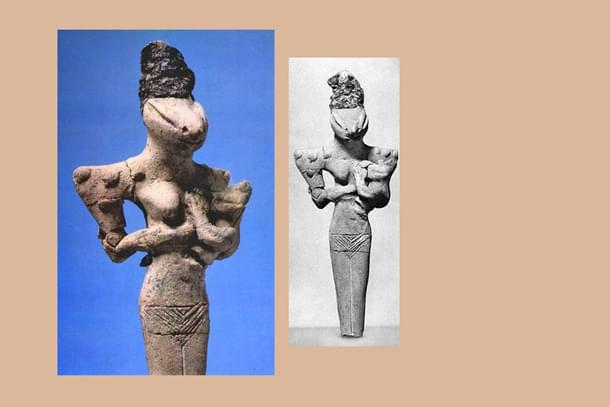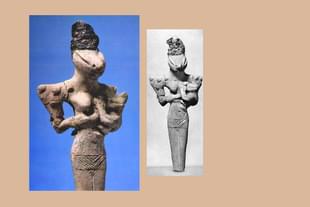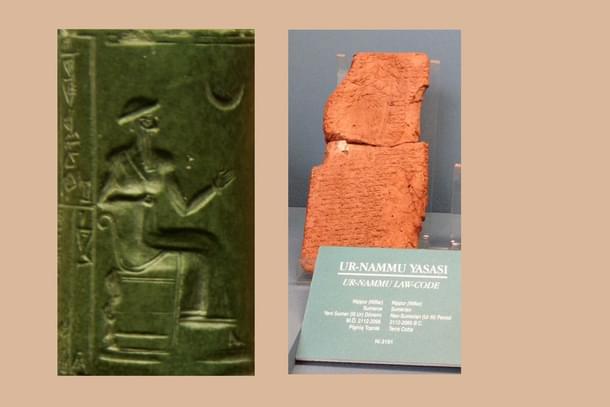Culture
Navratri Notes: Nammu, The Forgotten Serpent-Sea Goddess From Sumeria
Aravindan Neelakandan
Oct 03, 2024, 06:29 PM | Updated Oct 04, 2024, 06:25 PM IST
Save & read from anywhere!
Bookmark stories for easy access on any device or the Swarajya app.


Long before the Gods were born, She was there. From Her arise the multiverses, and the parallel universes. Into Her they dissolve.
Long before a species of bipedal apes, who would call themselves Homo sapiens, emerged on an insignificant planet orbiting a mediocre yellow star in the arm of a spiral galaxy, She was there.
Life, manifesting on the planet in infinite branches of the phylogenetic tree of evolution, would arise, seeking to reunite with Her. She is thus at once the loving Mother and the playful Child.
From the pseudopodia extended by the amoeba to feel and intake nourishment, to the satellite-mounted telescopes probing the expanses of the universe, in all manifestations of cognition, She is.
All Gods, even those who consider themselves monotheistic or monopolistic, are Her children. She belongs to no nation, yet all nations abide in Her. She manifests in all human endeavours that seek reunion with the Universal Consciousness, which is She.
This article is an attempt to explore nine Goddesses outside India. Forgotten due to the temporary dominance of jealous sky-bound Gods, She awaits rediscovery.
Goddess worship has existed in various forms since the dawn of human consciousness. Representations of the Divine Feminine appear in the Palaeolithic and Neolithic art of humanity.
Nammu
Almost 4,000 years ago, he was one of the most significant men of the bronze age. He was the founder of a clan that who would create a formidable empire. Arguably the earliest written law was given by him centuries before code of Hammurabi.
He was Ur-Nammu of Sumeria. He considered himself the father of his people. In his law, except for the crimes deserving capital punishment, most of the punishments were in the form of fines. He considered his subjects his children. But in his inscriptions he called himself the servant of the Goddess.

That Goddess was Nammu.
In the dawn of all beginnings, there was the cosmic waters, the chaos. In those waters of chaos and randomness, She became the primordial energy – the impulse of creation. She, the serpent goddess. Thus, She became the Mother of all Gods. From Her, all forces of creation and existence were born.
The primal waters of the beginning are called the ‘Apsu’. Nammu while being the creative impulse of creation is also the sea of the waters. 'Nammu' itself means sea for that was her cuneiform ideogram. She thus simultaneously is the ocean of water, symbolic of the primal matter in chaos and also the primordial creative impulse that generates all existence.
She becomes the image of Sumerian Advaita where Creation and the Creatrix are one. It was from Her body that the heavens and the earth arose as a great universal mountain, An-Ki.
An-Ki is a unified cosmic mountain uniting the heavens and earth. Heaven was An, the god, and Ki was earth the goddess. From this organic unity of the binary, all creation in Sumerian mythology arose.
As the Feminine serpent in the chaos of the primordial cosmic ocean, She is the primal creative impulse of all creation. She is that first seed of desire that entered the heat of non-existence to produce the existence, the connection that the Rishis realised in through meditation in their hearts.

In a striking Sumerian depiction, She is snake-faced and breast feeds a child.
This is quite a combination of two dominant branches of life tree in this planet: Reptilian and Mammalian. Reptilia and Mammalia shared a common ancestry in that great tree of life approximately 310 million years ago. Then from the reptilian common ancestor, the mammalia branched out.
In 1970s, Carl Sagan popularised the idea of Triune brain which was proposed by the famous neuroscientist Paul D. MacLean in the 1960s. According to the hypothesis, the brain was considered as having a primal reptilian complex, an emotional paleo-mammalian complex (limbic system), and a more rational neo-mammalian complex (neocortex).
With each layer being a custodian of distinct behaviours and cognition, the triune brain hypothesis wove a narrative as compelling as any enduring mythology with deep symbolic appeal.
Sagan in his adorable book Dragons of Eden, with a poetic flourish drew vivid parallels to the Biblical 'Garden of Eden' myth. He suggested that as humans evolved, our burgeoning neocortex—often considered the seat of morality and ethics—set us apart from our animal kin.
This evolutionary leap and cleave, however, came with a price: the pain of childbirth, a poignant reminder of our cerebral expansion. Thus the fruit of the tree of wisdom that told human brain right and wrong, came with the curse of pain in the child birth – a neurobiological retelling of Biblical Genesis.
Yet, as enchanting as the Triune Brain theory was, modern neuroscience has since revealed it as too simplistic and the compartmentalisation as defective. The brain, it turns out, is not a mere collection of isolated parts but a symphony of interconnected regions.
The so-called ‘reptilian’ brain and the neocortex are in constant dialogue, ‘a hallmark of the adaptability of networks—at both molecular and cognitive levels.’ This intricate interplay, effects adaptive change while maintaining organismal stability – both allostasis and homeostasis. This adaptive brain protects and nurtures survival and flourishing of the human species.
In essence, our brain is a dynamic, organic unity, a harmonious blend of various evolutionary epochs. It is as integrated and nurturing as Nammu, the serpent-headed Mother Goddess, breast feeding Her child, the humanity, embodying the profound interconnectedness of our neural heritage.
Is Nammu completely forgotten today?
In the West, She remains deeply enshrined in symbols. The Hermetic symbol of egg and the serpent could be one such.
Once revered as the Mother Goddess by the earliest law-giving king who declared himself Her servant, She evolved into the embodiment of Righteousness, guiding rulers as depicted in later Goddess iconography.
In Christian mythology, She transformed into the nurturing mother of her son, who would die and resurrect after three days—a motif predating Christianity, rooted in Sumerian Goddess tradition.
The image of Mary with her divine child traces back to Nammu, the Serpent Goddess, though here she is a subdued intermediary between the sky-borne male god and his only begotten male child.
In India, the Serpent Goddess thrives in all Her glory and She evolves. She is Kundalini, the essence of all creativity. She manifests in countless village Goddesses. In Bengal, She is Manasa; in Tamil Nadu, She is Nagaathamma.
Despite the tides of monopolistic invasions and proselytizing incursions, She lives and lives gloriously. Celebrated through diverse rituals and ancient as well as local Puranas, part of tantra and bhakti, She shines in Bharat with glory divine. Should Ur-Nammu return to our era, he would find his Goddess within India’s sacred traditions and would bow in reverence.





